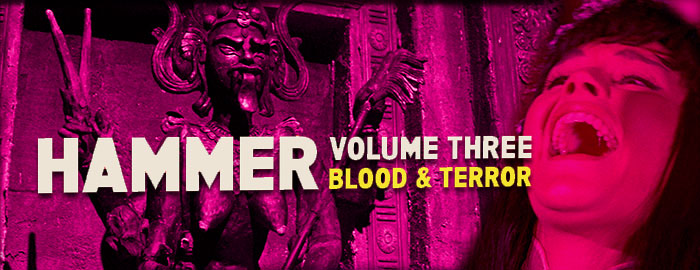
YESTERDAY'S ENEMY THE STRANGLERS OF BOMBAY THE CAMP ON BLOOD ISLAND
B&W, 1958, 80 mins. 57 secs.
Directed by Val Guest
Starring André Morell, Carl Möhner, Walter Fitzgerald, Edward Underdown, Phil Brown, Barbara Shelley, Michael Goodliffe, Ronald Radd
Indicator (Blu-ray) (UK R0 HD), Sony (DVD) (US R0 NTSC) / WS (2.35:1) (16:9)
B&W, 1959, 83 mins. 26 secs.
Directed by Val Guest
Starring Stanley Baker, Guy Rolfe, Leo McKern, Gordon Jackson, David Oxley
Indicator (Blu-ray) (UK R0 HD), Sony (DVD) (US R0 NTSC) / WS (2.35:1) (16:9)
B&W, 1959, 80 mins. 21 secs.
Directed by Terence Fisher
Starring Guy Rolfe, Allan Cuthbertson, Andrew Cruickshank, George Pastell, Marne Maitland
Indicator (Blu-ray) (UK R0 HD), Sony (DVD) (US R0 NTSC) / WS (2.35:1) (16:9)
THE TERROR OF THE TONGS
Color, 1961, 76 mins. 22 secs.
Directed by Anthony Bushell
Starring Christopher Lee, Yvonne Monlaur, Geoffrey Toone, Marne Maitland, Brian Worth, Ewen Solon, Burt Kwouk
Indicator (Blu-ray) (UK R0 HD), Sony (DVD) (US R0 NTSC) / WS (1.66:1) (16:9)
 its third boxed set
its third boxed set  outing devoted to the world of Hammer Films, Indicator shifts gears yet again after the prior offerings devoted to Gothic horror and suspense thrillers. This time the title, Hammer Volume Three: Blood and Terror, lives up to its title by exploring not the screaming and mayhem unleashed by monsters but instead the horrors mankind inflicts upon itself in real life. That means you get two war films that rank among the studio's best and a pair of its earliest and most notorious censorship-testing releases.
outing devoted to the world of Hammer Films, Indicator shifts gears yet again after the prior offerings devoted to Gothic horror and suspense thrillers. This time the title, Hammer Volume Three: Blood and Terror, lives up to its title by exploring not the screaming and mayhem unleashed by monsters but instead the horrors mankind inflicts upon itself in real life. That means you get two war films that rank among the studio's best and a pair of its earliest and most notorious censorship-testing releases. 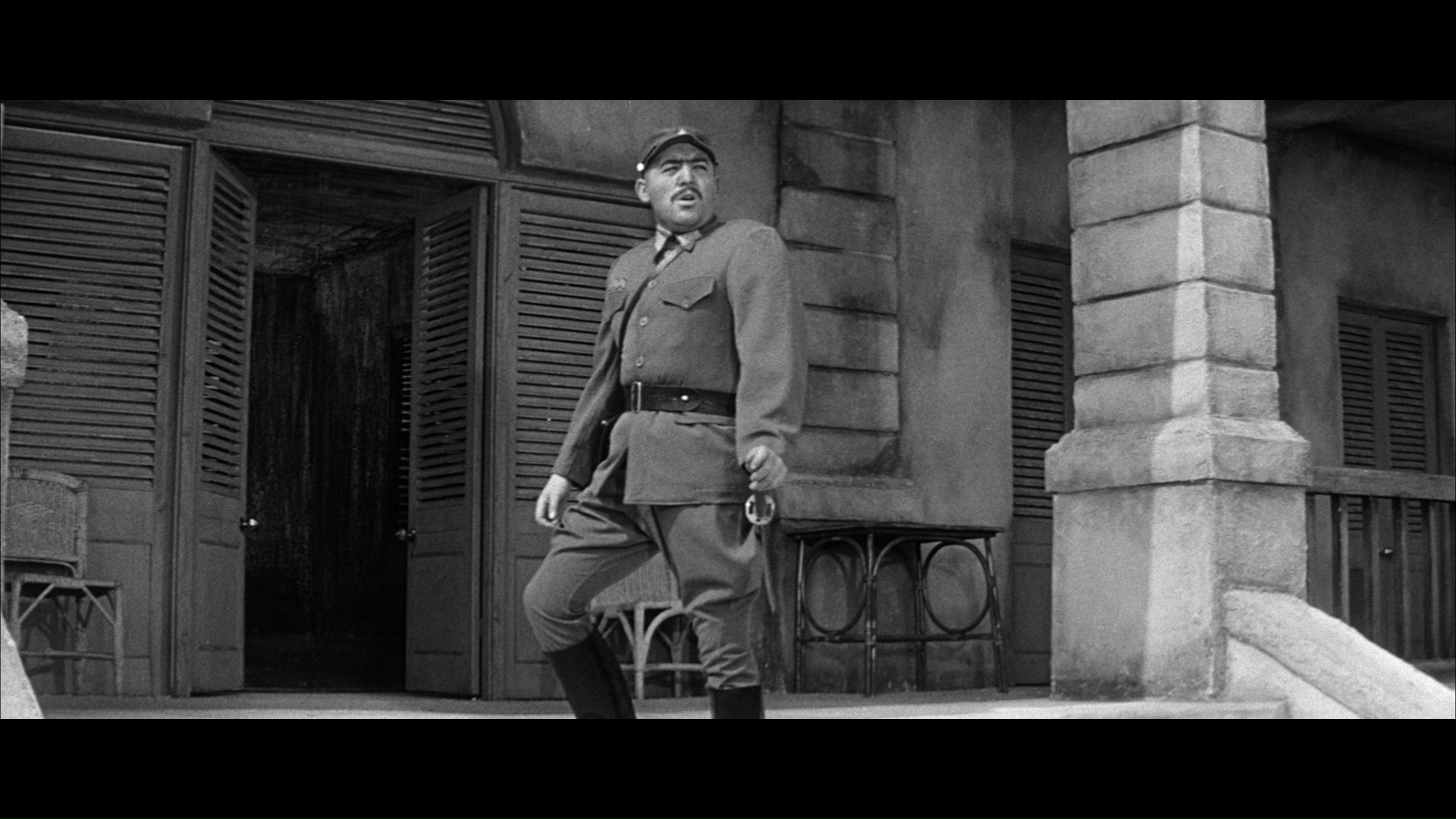 atmospheric sets go a long way here, and Morell, one of the more underrated Hammer leading men (also in Kwai as well as The Hound of the Baskervilles and Plague of the Zombies), gets a particularly juicy role here. The actual depiction of violence here isn't as explicit as you might expect from the title, but the heavy air of brutality and hair-trigger punishment is still unnerving with a frighteningly emaciated Richard Wordsworth (the ill-fated astronaut from The Quatermass Xperiment) providing the most disturbing imagery in his fairly small role.
atmospheric sets go a long way here, and Morell, one of the more underrated Hammer leading men (also in Kwai as well as The Hound of the Baskervilles and Plague of the Zombies), gets a particularly juicy role here. The actual depiction of violence here isn't as explicit as you might expect from the title, but the heavy air of brutality and hair-trigger punishment is still unnerving with a frighteningly emaciated Richard Wordsworth (the ill-fated astronaut from The Quatermass Xperiment) providing the most disturbing imagery in his fairly small role. 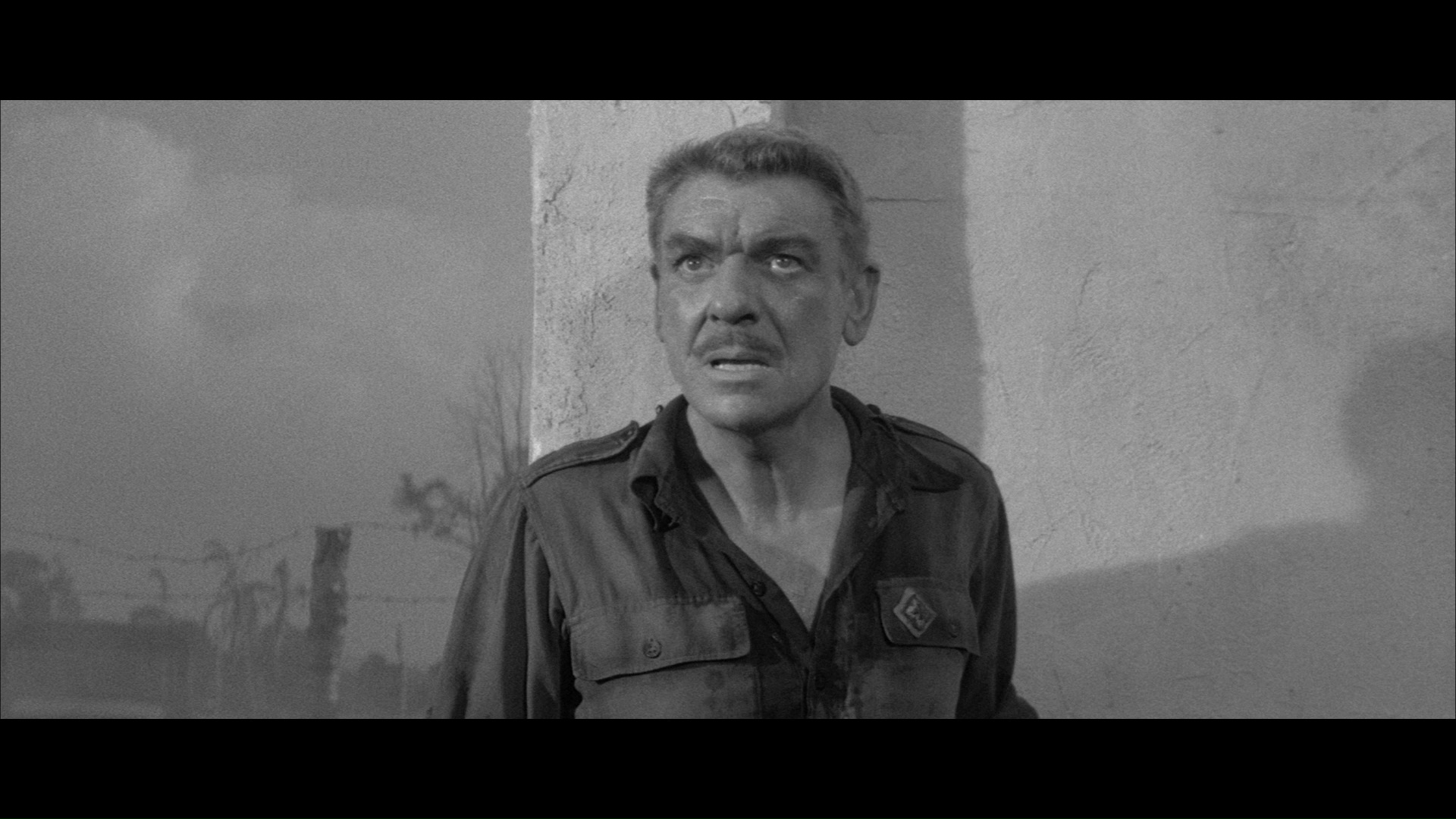
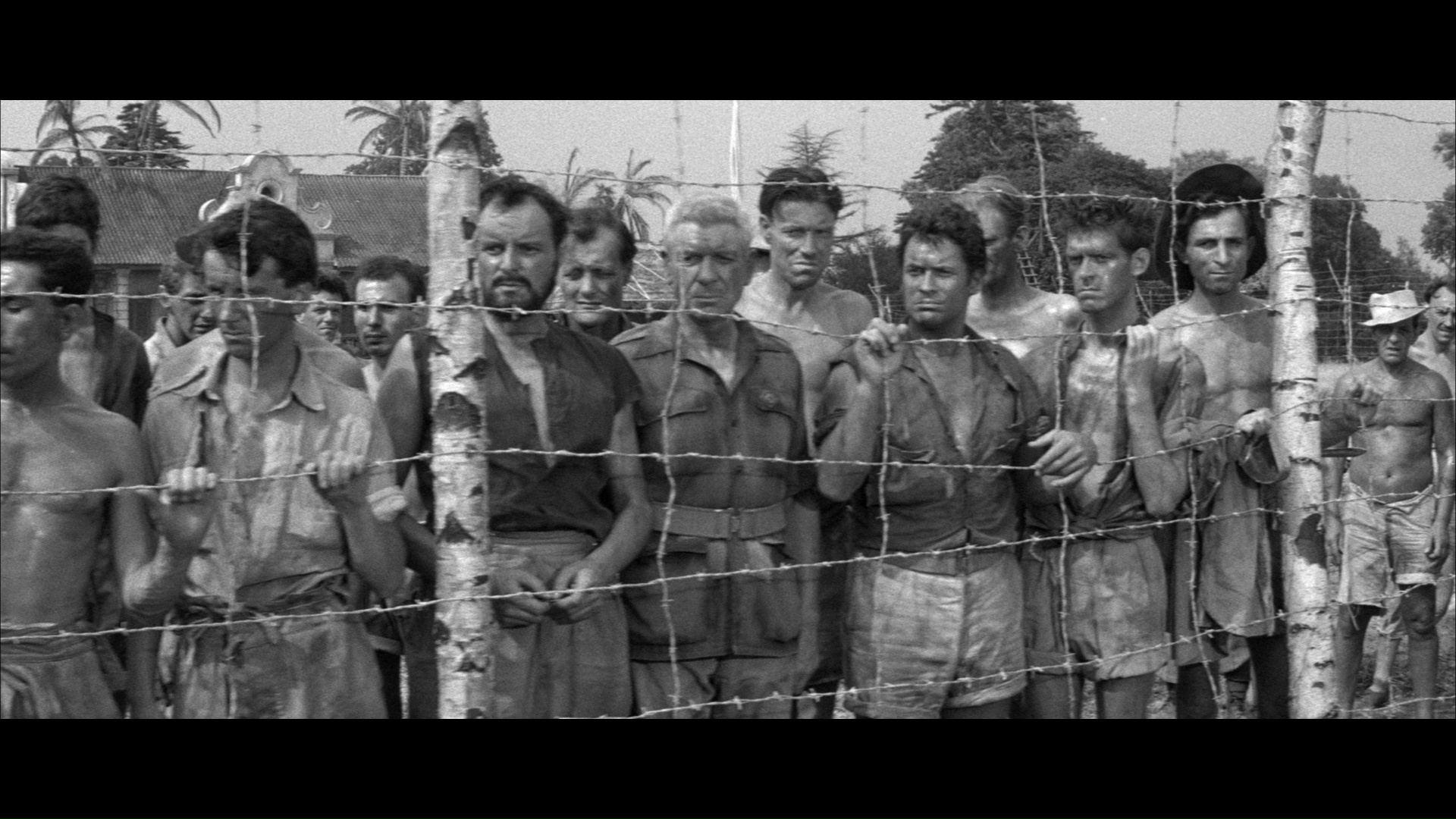 Barnes and Jonathan Rigby go further into the making of the film including its potential censorship issues, the purportedly true story that inspired it, and the implications of Hammer's recent status as a purveyor of horror films that would soon come to identify it entirely in the public eye. There's also a peek at the gruesome fate of regular Hammer character actor Michael Ripper, which was mandated to be less prolonged in the final film, as well as an explanation for why none of the (brief) Japanese dialogue is subtitled. Fortunately the sterling "Hammer's Women" series from the two past releases continues here and remains fascinating as always, this time with a focus on Mary Marrall (10m22s) including her notable stage career and a colorful roster of screen credits in films ranging from Dead of Night to The Belles of St. Trinian's, plus an analysis of how older women were integrated into Hammer's output. Guest's
Barnes and Jonathan Rigby go further into the making of the film including its potential censorship issues, the purportedly true story that inspired it, and the implications of Hammer's recent status as a purveyor of horror films that would soon come to identify it entirely in the public eye. There's also a peek at the gruesome fate of regular Hammer character actor Michael Ripper, which was mandated to be less prolonged in the final film, as well as an explanation for why none of the (brief) Japanese dialogue is subtitled. Fortunately the sterling "Hammer's Women" series from the two past releases continues here and remains fascinating as always, this time with a focus on Mary Marrall (10m22s) including her notable stage career and a colorful roster of screen credits in films ranging from Dead of Night to The Belles of St. Trinian's, plus an analysis of how older women were integrated into Hammer's output. Guest's 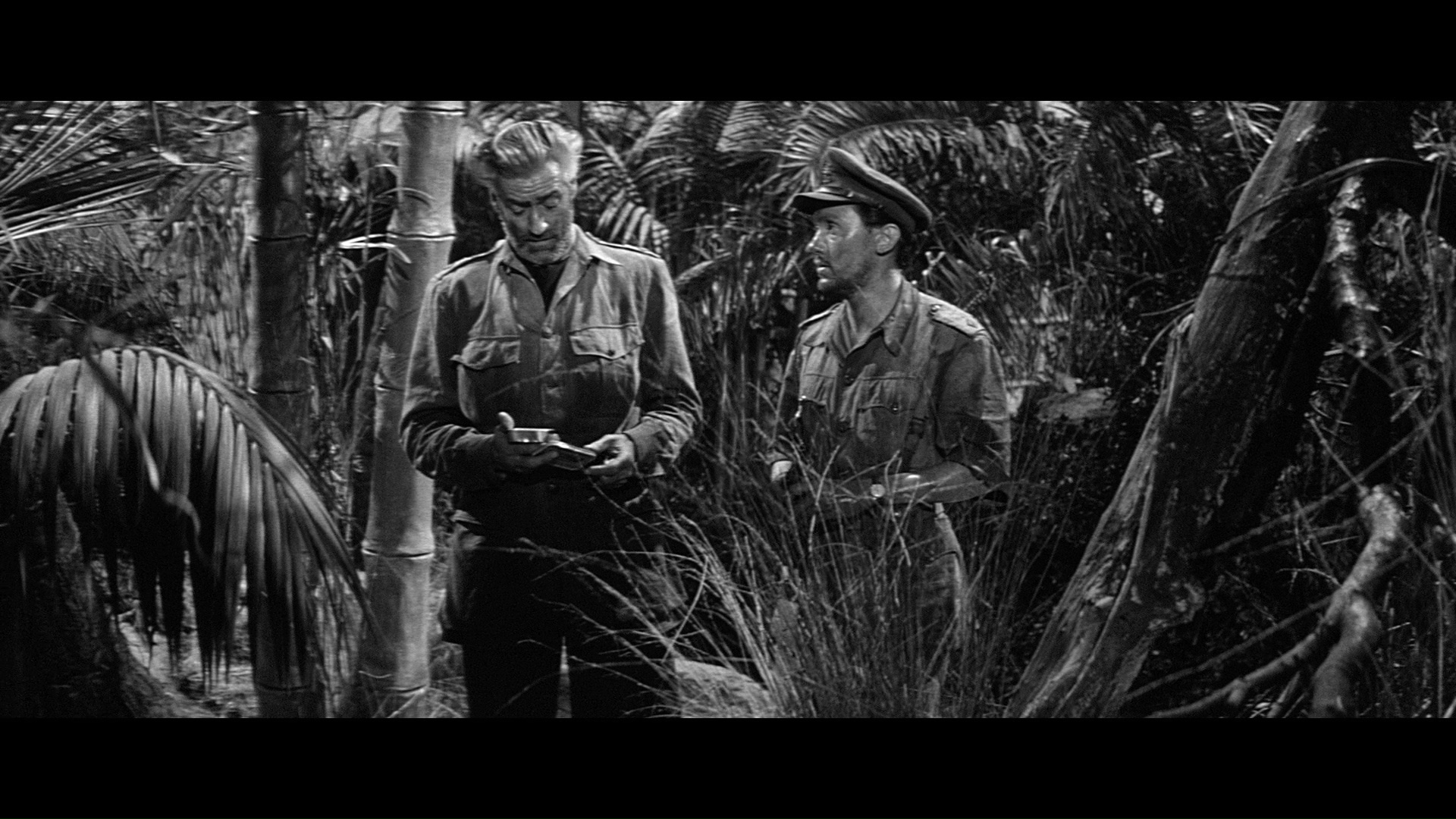 career gets spotlighted next in "From Light to Dark" (17m42s), with Professor Steve Chibnall providing background on the filmmaker's entry into the entertainment world and his ascension to shooting films at Hammer. "Return to Blood Island" (3m28s) features continuity supervisor Renée Glynne (and her scene-stealing pet dog) presenting stories from the shoot, focusing on Guest in particular. The theatrical trailer ("All of this is true!") is included along with a gallery of 58 images.
career gets spotlighted next in "From Light to Dark" (17m42s), with Professor Steve Chibnall providing background on the filmmaker's entry into the entertainment world and his ascension to shooting films at Hammer. "Return to Blood Island" (3m28s) features continuity supervisor Renée Glynne (and her scene-stealing pet dog) presenting stories from the shoot, focusing on Guest in particular. The theatrical trailer ("All of this is true!") is included along with a gallery of 58 images.  now sometimes pops up in lists of the studio's very best films. A swiftly made big-screen adaptation of a 1957 made-for-TV film (and stage play) written by future Doctor Who scribe Peter R. Newman, the film takes place in the early days of the war with downtrodden British forces in Burma coming across a village occupied by Japanese soldier. Following the ensuing skirmish, a surviving informer is targeted by Captain Langford (Baker) to reveal the whereabouts of a Japanese colonel in possession of some pivotal plans, and a decision soon follows to execute two villagers to get the information out of him. That tactic doesn't sit well with Padre
now sometimes pops up in lists of the studio's very best films. A swiftly made big-screen adaptation of a 1957 made-for-TV film (and stage play) written by future Doctor Who scribe Peter R. Newman, the film takes place in the early days of the war with downtrodden British forces in Burma coming across a village occupied by Japanese soldier. Following the ensuing skirmish, a surviving informer is targeted by Captain Langford (Baker) to reveal the whereabouts of a Japanese colonel in possession of some pivotal plans, and a decision soon follows to execute two villagers to get the information out of him. That tactic doesn't sit well with Padre 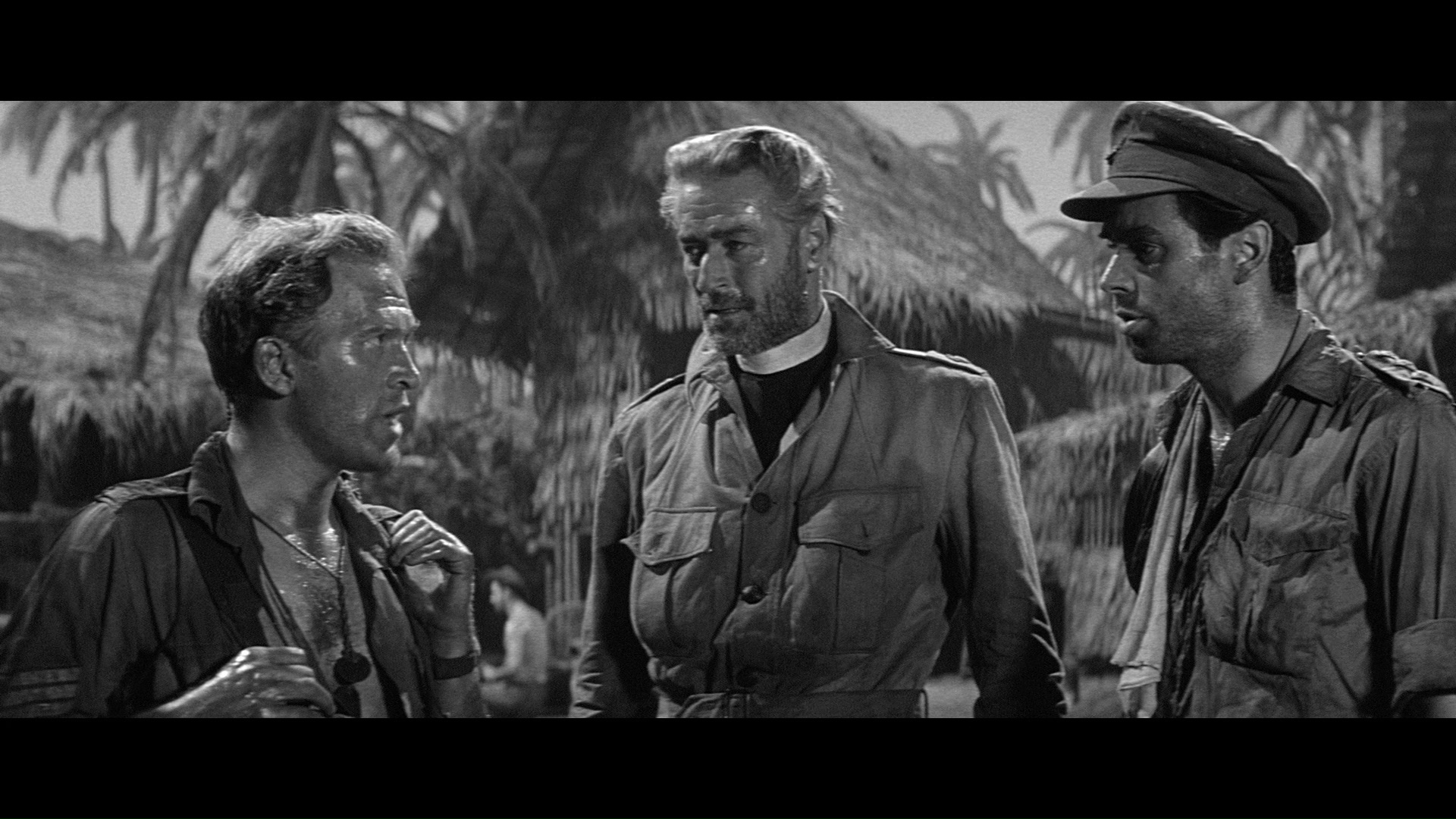 (Rolfe) and Max (McKern) who call it out as a war crime, but that's just the beginning when they soon run into more Japanese forces who turn the moral question around 180 degrees. Lean, mean, and unflinching, it's a prime acting showcase for a stellar cast including Baker (whose natural darkness serves him well here), Gordon Jackson (The Great Escape), a young Bryan Forbes in his acting days before he became a notable director, and even a briefly seen Burt Kwouk. The decision to leave out music of any kind adds to the suffocating, intense drama, and once again the decision to shoot in scope manages to compensate for the stage-bound shooting (in this case spanning two different sound stages).
(Rolfe) and Max (McKern) who call it out as a war crime, but that's just the beginning when they soon run into more Japanese forces who turn the moral question around 180 degrees. Lean, mean, and unflinching, it's a prime acting showcase for a stellar cast including Baker (whose natural darkness serves him well here), Gordon Jackson (The Great Escape), a young Bryan Forbes in his acting days before he became a notable director, and even a briefly seen Burt Kwouk. The decision to leave out music of any kind adds to the suffocating, intense drama, and once again the decision to shoot in scope manages to compensate for the stage-bound shooting (in this case spanning two different sound stages).  The Guardian interview with Guest conducted by Rigby (for a screening of Hell Is a City), and though it doesn't directly relate to the feature itself all that much, it's a frequently hilarious 45-minute account of his career; from finding out his personal favorites of his work (some choices are a little surprising) to the prescience of
The Guardian interview with Guest conducted by Rigby (for a screening of Hell Is a City), and though it doesn't directly relate to the feature itself all that much, it's a frequently hilarious 45-minute account of his career; from finding out his personal favorites of his work (some choices are a little surprising) to the prescience of 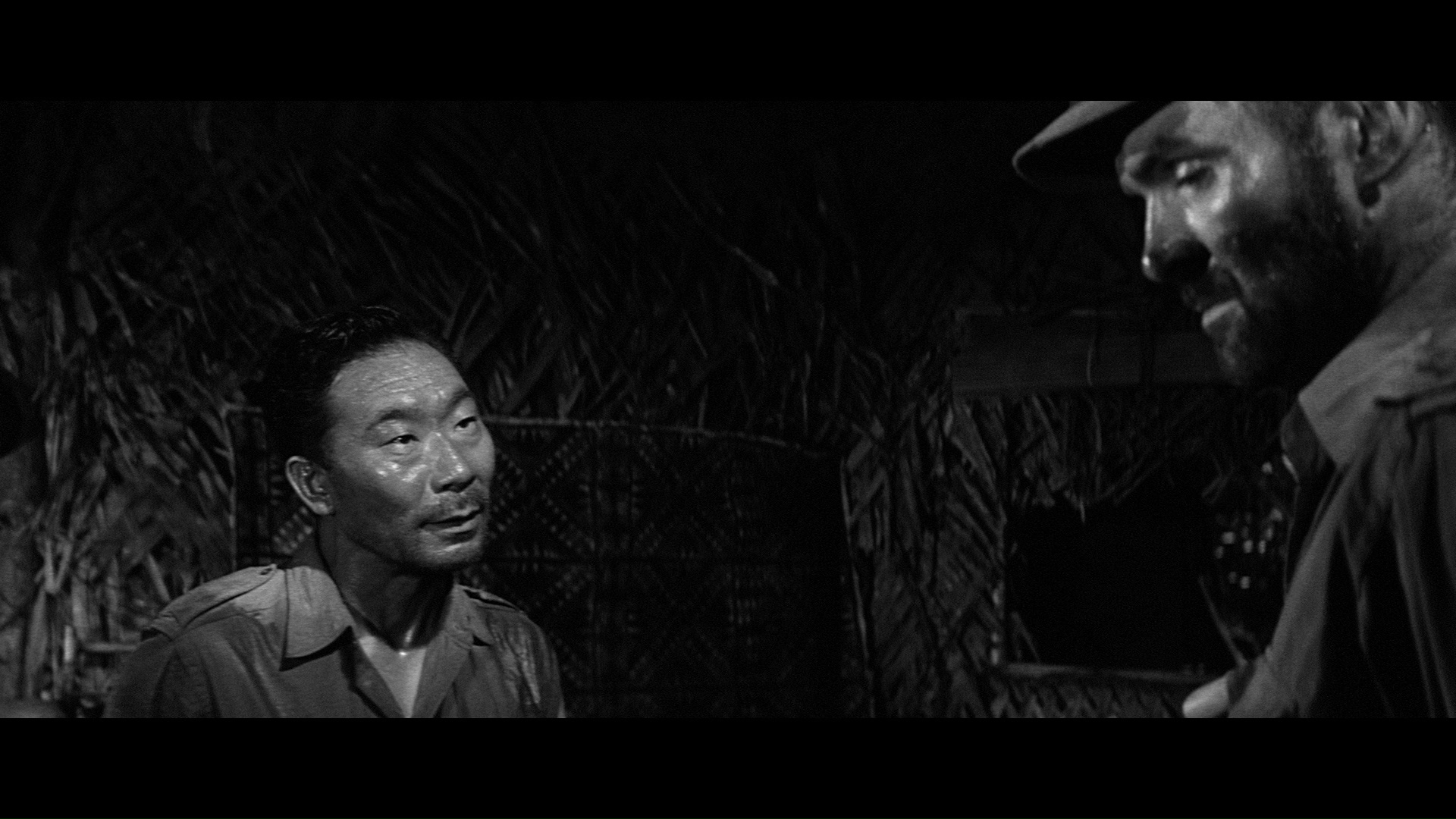 The Day the Earth Caught Fire. The featurette "Total War: Inside Yesterday's Enemy" (24m43s) brings back Barnes and Rigby for a dissection of the film as a response to the racist charges against Blood Island, the process of bringing Guest on board and getting Newman to write the screenplay, the film's opening in Japan before its U.K. premiere, and the contrasting censorship issues the film faced in its two biggest territories. This entry of "Hammer's Women" focuses on Edwina Carroll (7m56s) with Becky Booth offering an overview of the thespian who often appeared in small or overlooked parts and cut a memorable figure as the stewardess in 2001: A Space Odyssey as well as bit parts in both of these Guest war films. A video intro by Laws (8m6s) offers an informative overview of the film (you might want to watch it before the film as it gives some helpful context without spoiling anything), while "New Territory" (12m53s) features Chibnall dissecting the film's anti-war stance, the necessity of spending more money to use space at Shepperton Studios, and the use of natural sounds like birds and wind instead of music (which of course precedes Hitchcock's The Birds). In "Frontline Dispatches" (8m8s), second assistant director Hugh Harlow and props charge-hand Peter Allchorne offer their own memories from working in the trenches and learning about how camera angles could create a palpable sense of location.
The Day the Earth Caught Fire. The featurette "Total War: Inside Yesterday's Enemy" (24m43s) brings back Barnes and Rigby for a dissection of the film as a response to the racist charges against Blood Island, the process of bringing Guest on board and getting Newman to write the screenplay, the film's opening in Japan before its U.K. premiere, and the contrasting censorship issues the film faced in its two biggest territories. This entry of "Hammer's Women" focuses on Edwina Carroll (7m56s) with Becky Booth offering an overview of the thespian who often appeared in small or overlooked parts and cut a memorable figure as the stewardess in 2001: A Space Odyssey as well as bit parts in both of these Guest war films. A video intro by Laws (8m6s) offers an informative overview of the film (you might want to watch it before the film as it gives some helpful context without spoiling anything), while "New Territory" (12m53s) features Chibnall dissecting the film's anti-war stance, the necessity of spending more money to use space at Shepperton Studios, and the use of natural sounds like birds and wind instead of music (which of course precedes Hitchcock's The Birds). In "Frontline Dispatches" (8m8s), second assistant director Hugh Harlow and props charge-hand Peter Allchorne offer their own memories from working in the trenches and learning about how camera angles could create a palpable sense of location. 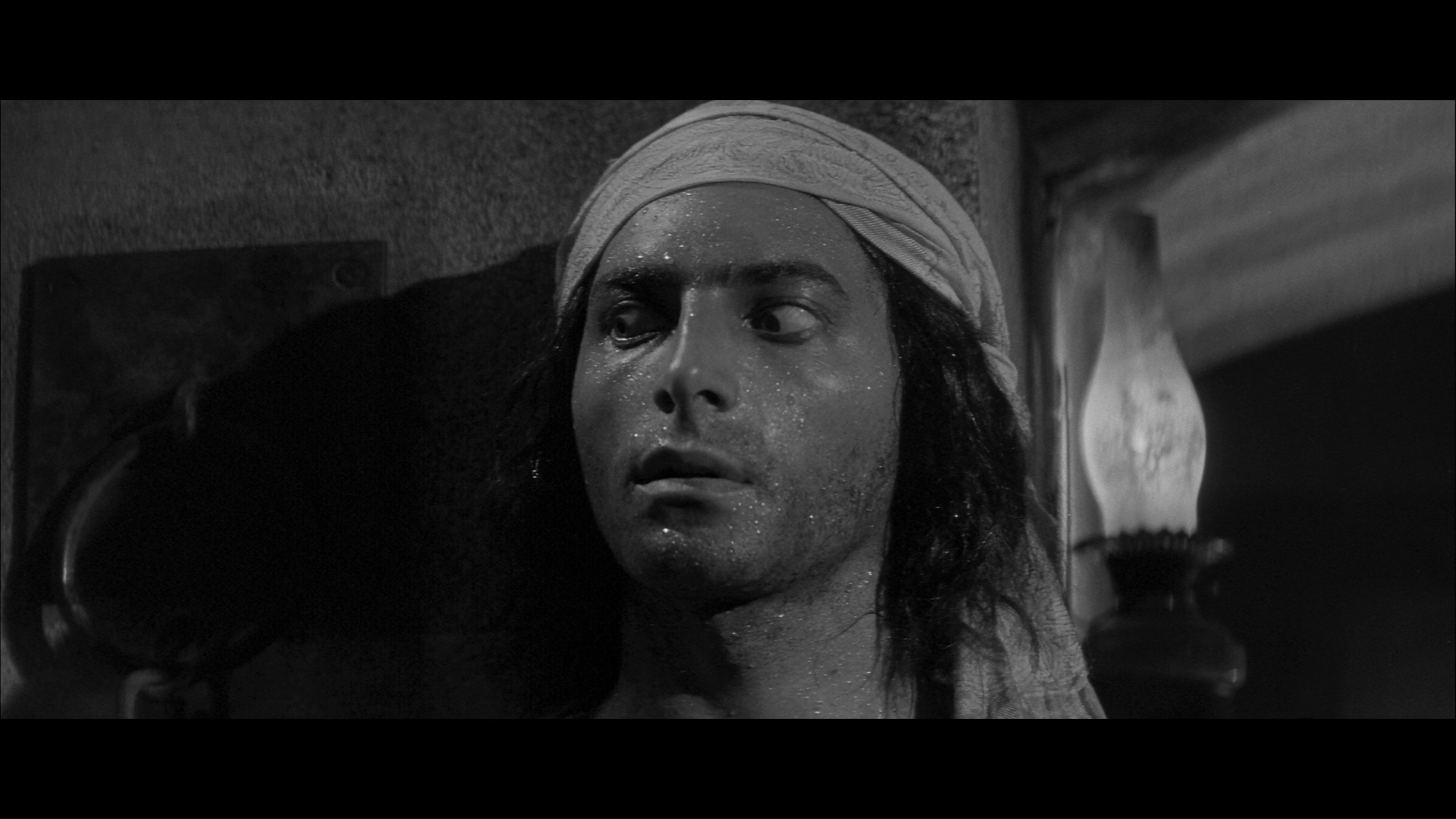 Finally the disc rounds out with the theatrical trailer and a gallery of 131(!) images.
Finally the disc rounds out with the theatrical trailer and a gallery of 131(!) images. 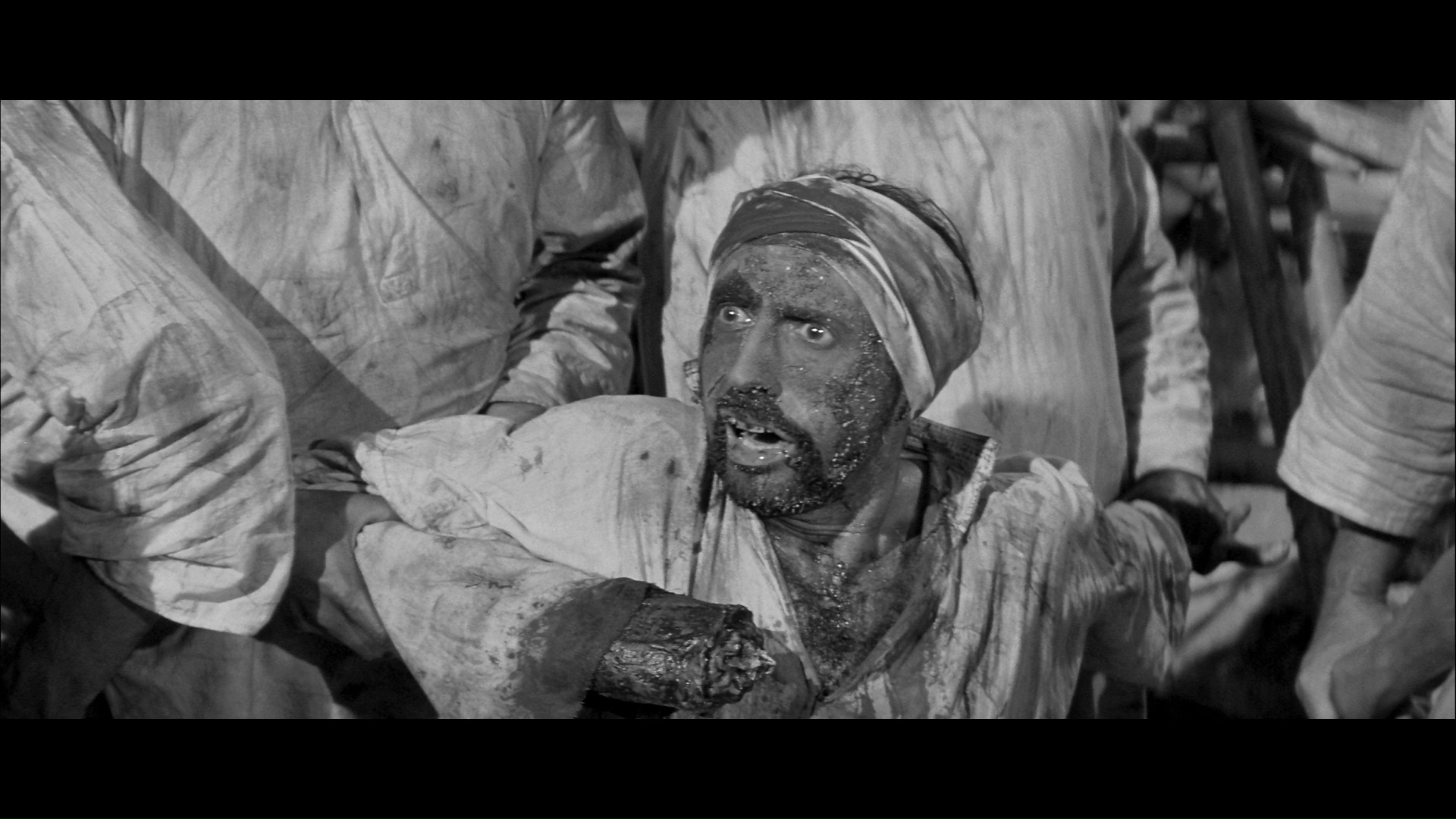 savage and still potent The Stranglers of Bombay is a brutal depiction of the activities of India's Thuggee cult in the 1830s, which famously became the villains of Steven Spielberg's Indiana Jones and the Temple of Doom. When natives and animals seem to be going missing in alarmingly large numbers and the local trade is upended by violence, Captain Harry Lewis (Rolfe again) believes an "evil perverted sect" is at work in service of a dark goddess, Kali. Though initially passed over to head an investigation, he persists and puts his own life in peril at the hands of the cult who rely on sacrifice and spies to commit their nefarious deeds in the region.
savage and still potent The Stranglers of Bombay is a brutal depiction of the activities of India's Thuggee cult in the 1830s, which famously became the villains of Steven Spielberg's Indiana Jones and the Temple of Doom. When natives and animals seem to be going missing in alarmingly large numbers and the local trade is upended by violence, Captain Harry Lewis (Rolfe again) believes an "evil perverted sect" is at work in service of a dark goddess, Kali. Though initially passed over to head an investigation, he persists and puts his own life in peril at the hands of the cult who rely on sacrifice and spies to commit their nefarious deeds in the region. 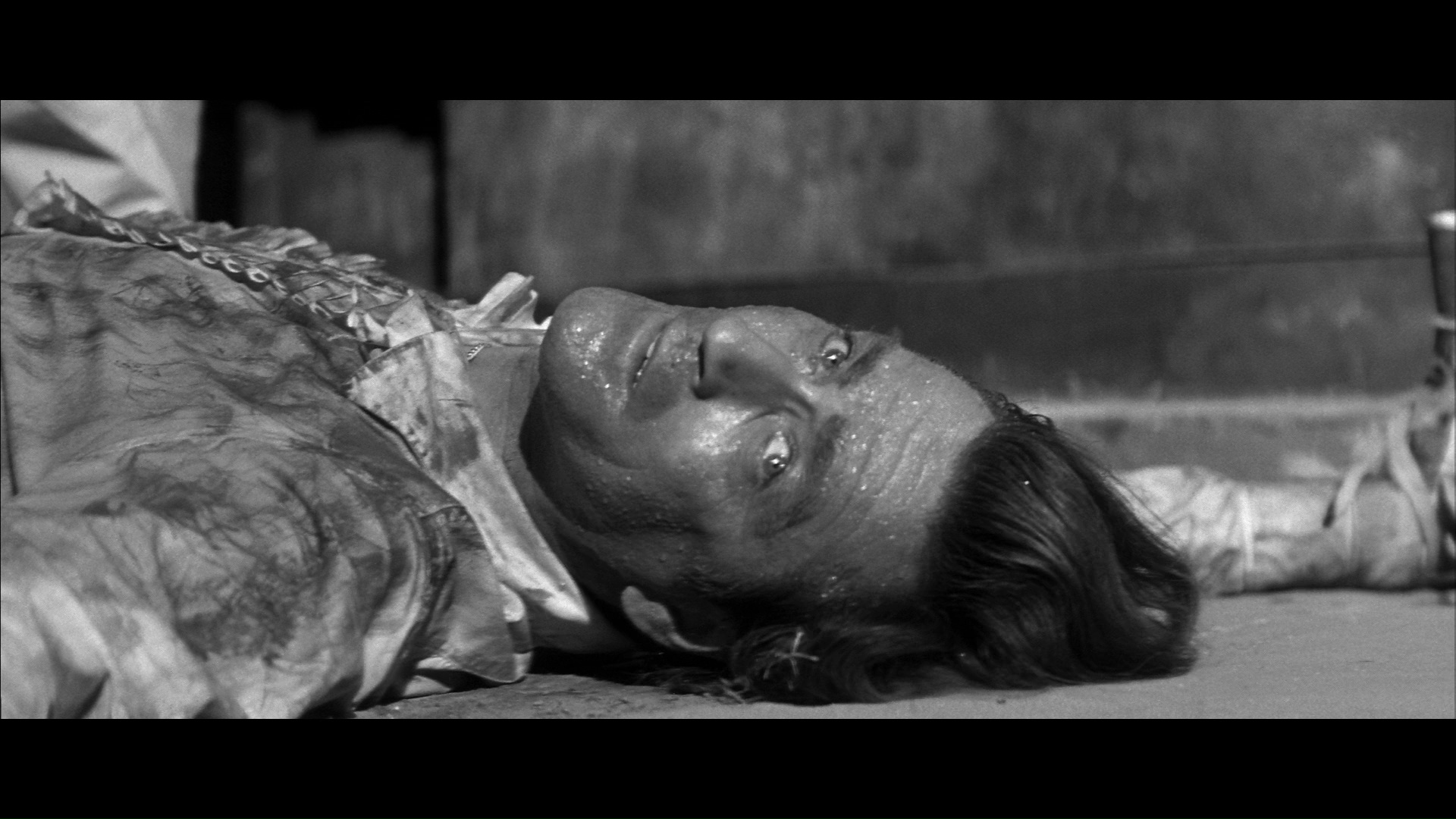 number of sets turned into a cinematic fantasyland, the perfect backdrop for dialogue like "Kali will not be denied!" This one actually had a pressed, commercial DVD as part of Sony's four-film "Icons of Adventure" set along with Terror of the Tongs (more on that below), Pirates of Blood River, and The Devil-Ship Pirates. The Indicator Blu-ray features no less than three cuts of the film: the U.K. theatrical release (80m17s), which is slightly toned down in terms of violence; the
number of sets turned into a cinematic fantasyland, the perfect backdrop for dialogue like "Kali will not be denied!" This one actually had a pressed, commercial DVD as part of Sony's four-film "Icons of Adventure" set along with Terror of the Tongs (more on that below), Pirates of Blood River, and The Devil-Ship Pirates. The Indicator Blu-ray features no less than three cuts of the film: the U.K. theatrical release (80m17s), which is slightly toned down in terms of violence; the  U.S. theatrical version (79m52s), which is edited quite differently in spots and has a very different, abbreviated opening but more brutality; and an integral version with all footage from both releases (80m21s). A helpful "About the Versions" featurette (6m35s) charts the variations between the two original release editions, which are brief but fascinating as they feature different amounts of branding, mugging, and eroticized reaction shots. Apart from one little rough patch of fuzzy optical work after the opening crawl, the film is in mint condition and looks gorgeous. Ported over from the older DVD is an audio commentary with screenwriter David Z Goodman (for the U.S. cut), with the future writer of Straw Dogs and Eyes of Laura Mars reacting to the film while watching it for the first time in decades. It's a quiet, sparse track at first, but he eventually warms up and chats about how he became involved with Hammer, wrote this around the same time he was doing plays, doesn't care for the slow pacing, and rubbed shoulders with some very famous
U.S. theatrical version (79m52s), which is edited quite differently in spots and has a very different, abbreviated opening but more brutality; and an integral version with all footage from both releases (80m21s). A helpful "About the Versions" featurette (6m35s) charts the variations between the two original release editions, which are brief but fascinating as they feature different amounts of branding, mugging, and eroticized reaction shots. Apart from one little rough patch of fuzzy optical work after the opening crawl, the film is in mint condition and looks gorgeous. Ported over from the older DVD is an audio commentary with screenwriter David Z Goodman (for the U.S. cut), with the future writer of Straw Dogs and Eyes of Laura Mars reacting to the film while watching it for the first time in decades. It's a quiet, sparse track at first, but he eventually warms up and chats about how he became involved with Hammer, wrote this around the same time he was doing plays, doesn't care for the slow pacing, and rubbed shoulders with some very famous 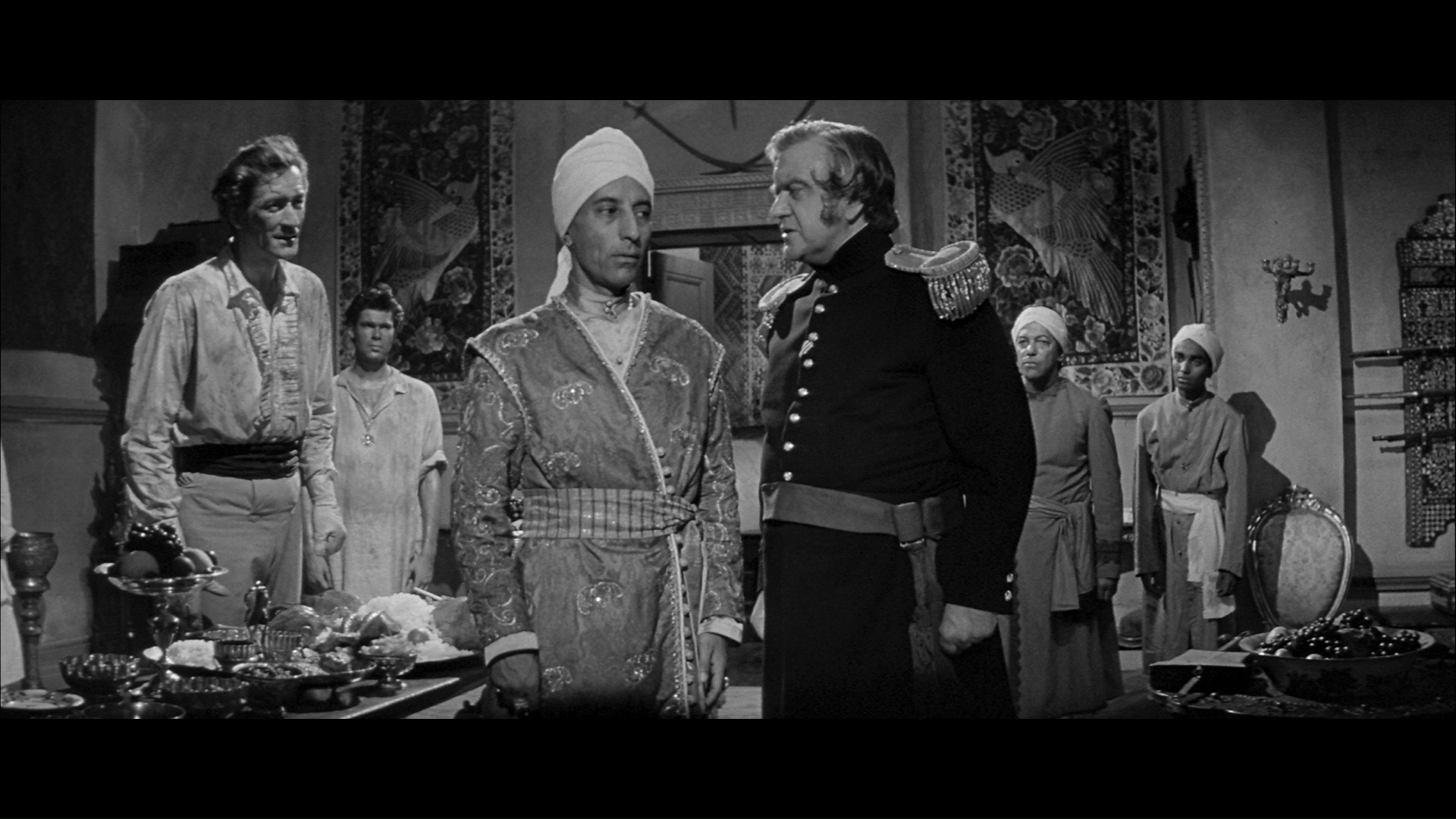 comedians. "Ritual Murder: Inside The Stranglers of Bombay" (16m47s) picks up where the other featurettes left off as Barnes and Rigby chat about the American involvement in the film, its genesis after the rights weren't available for the similar The Deceivers, the similarities to the western genre, the rumors that Fisher himself was horrified by the final result, and the significant crew members on the shoot at Bray. The "Hammer's Women" for this one turns to Jan Holden (5m32s),
comedians. "Ritual Murder: Inside The Stranglers of Bombay" (16m47s) picks up where the other featurettes left off as Barnes and Rigby chat about the American involvement in the film, its genesis after the rights weren't available for the similar The Deceivers, the similarities to the western genre, the rumors that Fisher himself was horrified by the final result, and the significant crew members on the shoot at Bray. The "Hammer's Women" for this one turns to Jan Holden (5m32s), 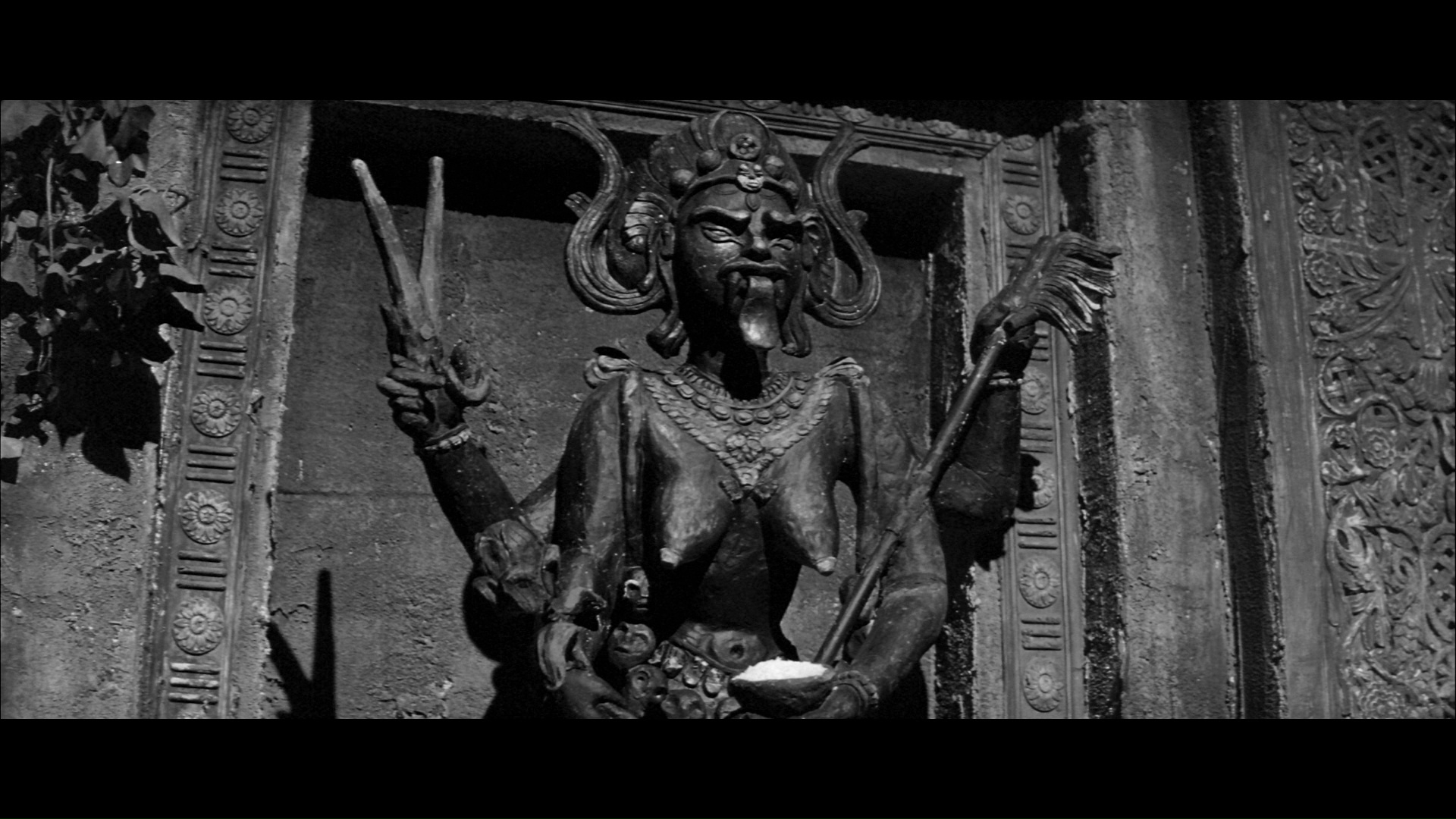 who plays Rolfe's wife in the film, with Colette Balmain briefly chatting about her TV roles and her versatility in everything from light comedy to serious dramas. In "The Stranglers of Bombay and the Censor" (26m56s), former BBFC examiner Richard Falcon delves into the film's tricky history including three apparently minimal cuts that have never been recovered, the recent X category at the time designed to protect children, and the "bestial" depictions that led to the film's trimming on the way to movie projectors. Perhaps the most fascinating extra on this disc (and maybe even the entire set) is "Musical Orientalism" (16m59s) with Hammer Film Scores and the Musical Avant-Garde author David Huckvale examining the significance of this score for the India-born James Bernard with percussion playing a particularly important role here and musical influences creeping through including Benjamin Britten. Also included are the theatrical trailer, in its original form and a Trailers from Hell edition hosted by Brian Trenchard-Smith, and a 49-image gallery.
who plays Rolfe's wife in the film, with Colette Balmain briefly chatting about her TV roles and her versatility in everything from light comedy to serious dramas. In "The Stranglers of Bombay and the Censor" (26m56s), former BBFC examiner Richard Falcon delves into the film's tricky history including three apparently minimal cuts that have never been recovered, the recent X category at the time designed to protect children, and the "bestial" depictions that led to the film's trimming on the way to movie projectors. Perhaps the most fascinating extra on this disc (and maybe even the entire set) is "Musical Orientalism" (16m59s) with Hammer Film Scores and the Musical Avant-Garde author David Huckvale examining the significance of this score for the India-born James Bernard with percussion playing a particularly important role here and musical influences creeping through including Benjamin Britten. Also included are the theatrical trailer, in its original form and a Trailers from Hell edition hosted by Brian Trenchard-Smith, and a 49-image gallery.  that thrived on vice, terror and corruption - The Red Dragon Tong!" And they aren't kidding since we get to see a man hatcheted in the gut in full bloody color before the
that thrived on vice, terror and corruption - The Red Dragon Tong!" And they aren't kidding since we get to see a man hatcheted in the gut in full bloody color before the  main titles even roll. The Tongs' leader, Chung King (Lee), runs an organization of intimidation and rampant slaughter that also wreaks havoc on the East India Trading Company, but he makes it personal when an attack claims the life of the implausibly sixteen-year-old daughter of Captain Jackson Sale (Toone). The enraged, grieving Sale declares war on the finger-severing Tongs, who are looking for an incriminating piece of paper, with housemaid Lee (Monlaur) enlisted to help him in a battle of wits against the nefarious Tong leader as the body count piles up.
main titles even roll. The Tongs' leader, Chung King (Lee), runs an organization of intimidation and rampant slaughter that also wreaks havoc on the East India Trading Company, but he makes it personal when an attack claims the life of the implausibly sixteen-year-old daughter of Captain Jackson Sale (Toone). The enraged, grieving Sale declares war on the finger-severing Tongs, who are looking for an incriminating piece of paper, with housemaid Lee (Monlaur) enlisted to help him in a battle of wits against the nefarious Tong leader as the body count piles up. in 1961 to play an aphorism-loaded Chinese character; he also took on the role of Ling Chu in the Edgar Wallace film The Devil's Daffodil, speaking German no less. Theatrical and imposing, he's great fun to watch as always and virtually worth the time invested in the film all by himself. On the downside, director Anthony Bushell -- an established actor who
in 1961 to play an aphorism-loaded Chinese character; he also took on the role of Ling Chu in the Edgar Wallace film The Devil's Daffodil, speaking German no less. Theatrical and imposing, he's great fun to watch as always and virtually worth the time invested in the film all by himself. On the downside, director Anthony Bushell -- an established actor who 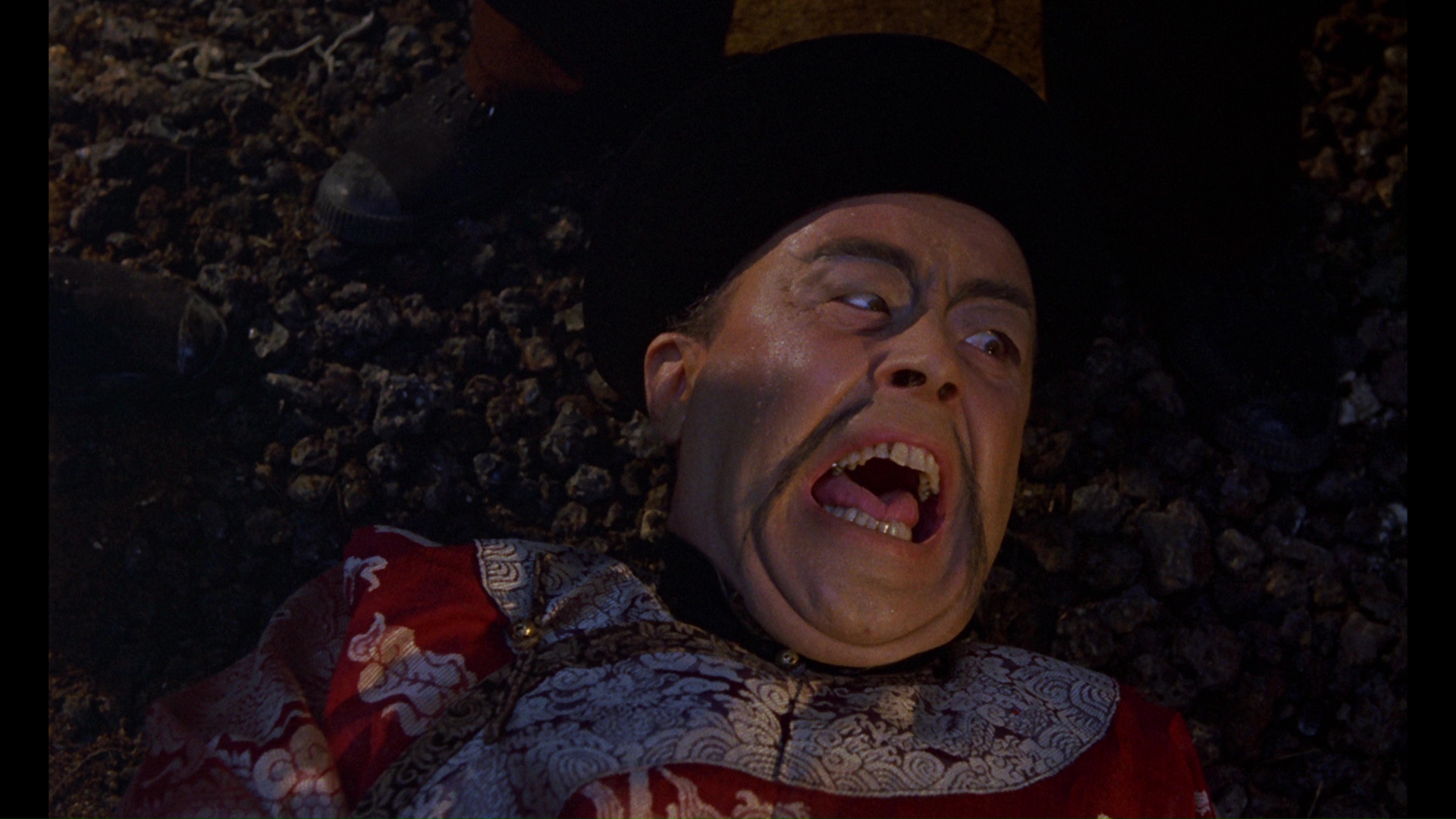 tried to take a crack at going behind the camera for a little while -- isn't exactly Terence Fisher or Val Guest; the whole film is flooded with light and feels way more stage-bound than the others in this set, even when it moves "outside" for the action scenes. That flaw aside, it's still great fun and, at less than 80 minutes, never outstays its welcome.
tried to take a crack at going behind the camera for a little while -- isn't exactly Terence Fisher or Val Guest; the whole film is flooded with light and feels way more stage-bound than the others in this set, even when it moves "outside" for the action scenes. That flaw aside, it's still great fun and, at less than 80 minutes, never outstays its welcome.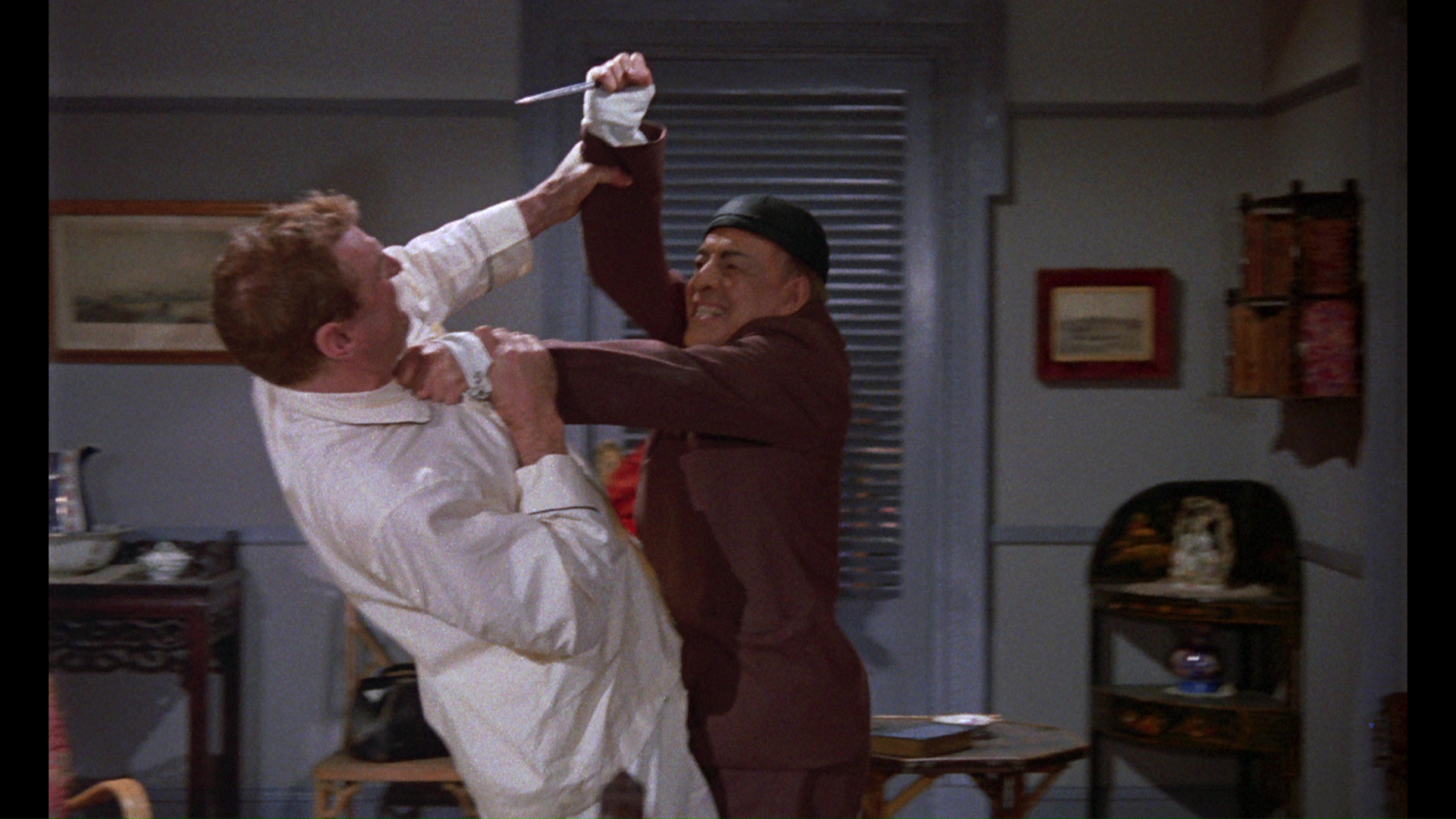 "Hammer's Women" is devoted to Monlaur (6m2s) with Laura Mayne chatting about the Parisian-born actor's work in England including Circus of Horrors,
"Hammer's Women" is devoted to Monlaur (6m2s) with Laura Mayne chatting about the Parisian-born actor's work in England including Circus of Horrors,  The Brides of Dracula, and this film. This marks her second time in front of the camera in an Indicator set and she does a really great, enthusiastic job on this one; here's hoping she makes some return engagements. A new intro by Laws (8m3s) covers the presence of Hammer bit player vet Milton Reid, the X certificate notoriety, and the debate about violence at the time. Huckvale turns up again for what amounts to a sequel to his other piece with "Hammer and Tongs" (10m21s), with further analysis of James Bernard's work drawing this time on Chinese influences and the standard "yellow peril" conventions of the time. (Again, it would be great to have him back on future releases.) Finally assistant costume designer Yvonne Blake appears in "Shear Terror" (2m40s) for a quick reminiscence about creating the costumes for all of the female characters. A trailer and a 56-image gallery are also included. The limited 6,000-unit box also comes with 40-page booklets for each title, with new essays appearing from Kim Newman, Neil Mitchell, James Oliver and Samm Deighan, along with vintage cast and crew interviews, samples from the original pressbook extracts and reviews, and film credits.
The Brides of Dracula, and this film. This marks her second time in front of the camera in an Indicator set and she does a really great, enthusiastic job on this one; here's hoping she makes some return engagements. A new intro by Laws (8m3s) covers the presence of Hammer bit player vet Milton Reid, the X certificate notoriety, and the debate about violence at the time. Huckvale turns up again for what amounts to a sequel to his other piece with "Hammer and Tongs" (10m21s), with further analysis of James Bernard's work drawing this time on Chinese influences and the standard "yellow peril" conventions of the time. (Again, it would be great to have him back on future releases.) Finally assistant costume designer Yvonne Blake appears in "Shear Terror" (2m40s) for a quick reminiscence about creating the costumes for all of the female characters. A trailer and a 56-image gallery are also included. The limited 6,000-unit box also comes with 40-page booklets for each title, with new essays appearing from Kim Newman, Neil Mitchell, James Oliver and Samm Deighan, along with vintage cast and crew interviews, samples from the original pressbook extracts and reviews, and film credits.